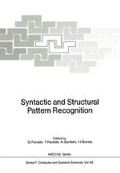Abstract
Shape recognition by fast syntactic methods is possible when there exists a natural linear (one-dimensional) order on component shapes. This may not be available for “structural” shape descriptions taking the form of unordered, variable-length sets of simpler shapes. In this case, it is tempting to fall back on slower exhaustive correlation, graph matching, and relaxation methods. However, if the structural shapes are themselves “simple”, it is possible to apply multi-dimensional search techniques for asymptotically fast feature identification. I exploit the fact that many simple shape types may be parameterized as points in low-dimensional spaces where distance models dissimilarity. During training, shapes are clustered heuristically within each class, then among all classes, giving a small set of characteristic shape distributions. Each of these is then associated with a binary feature variable taking the value one when any input shape falls within the distribution. This mapping from a structural description into a bit-vector is an example of a “feature identification” method. Selecting such a mapping is slow and heuristic, but fully automated, applicable uniformly to many shape types, and controlled by only a few natural statistical parameters. A mapping, once selected, can be applied quickly using kD-trees. Large-scale, statistically-significant trials have shown the technique to be superior to simpler fixed mappings, in an OCR context.
Access this chapter
Tax calculation will be finalised at checkout
Purchases are for personal use only
Preview
Unable to display preview. Download preview PDF.
References
Ballard, D. H., “Generalizing the Hough Transform to Detect Arbitrary Shapes”, Pattern Recognition 13, 1981, pp. 111–122.
Bentley, J. L., Friedman, J. H., “Data Structures for Range Searching,” Computing Surveys, Vol. 11, no. 4, December 1979, pp. 397–409.
Cox, C. H., P. Coueignoux, B. Blesser, and M. Eden “Skeletons: A Link between Theoretical and Physical Letter Descriptions,” Pattern Recognition, 15 (1982), pp. 11–22.
Duda, R. O., and Hart, P. E., “Use of the Hough Transform to Detect Lines and Curves in Pictures”, Graphics and Image Processing 15, 1972, pp. 11–15.
Duda, R. O., and Hart, P. E., Pattern Classification and Scene Analysis, Wiley (New York, 1973), Sects. 2.9-2.10.
Feller, W., An Introduction to Probability Theory and Its Applications, Wiley (New York, 1968), Chapter VI.
Harmon, L.D., “Automatic Recognition of Print and Script,” Proceedings of the IEEE, vol 60, October 1972, pp. 1165–1176.
Hartigan, J. A., Clustering Algorithms, Wiley (New York, 1975), Chapter 4.
Hattich, W., Tropf, H., and Winkler, G., “Combination of Statistical and Syntactical Pattern Recognition – Applied to Classification of Unconstrained Handwritten Numerals”, Proceedings of the Fourth International Conference on Pattern Recognition, Kyoto, Japan, November 7–10, 1978, pp. 786–788.
Fu, K. S., Syntactic Methods in Pattern Recognition, Academic Press (New York, 1974).
Fukunaga, K., Introduction to Statistical Pattern Recognition, Academic Press (New York, 1972).
Lashas, A., Shurna, R., Verikas, A., & Dosinas, A., “Optical Character Recognition Based on Analog Preprocessing and Automatic Feature Extraction”, Computer Vision, Graphics, and Image Processing, vol. 32, pp. 191–207, 1985.
Kahan, S. “Problems in Recognizing Handprinted Characters,” M. S. thesis, Dept. of EECS, Univ. of California, Berkeley, Febr. 1985.
Lam, S., and Baird, H. S., Performance Testing of Mixed-font, Variable-size Character Recognizers, AT& T Bell Labs, in preparation.
Mori, S., Yamamoto, K., Yasuda, M., “Research on Machine Recognition of Handprinted Characters,” IEEE Transactions on Pattern Analysis and Machine Intelligence„ vol PAMI-6, no 4, July, 1984, pp. 386–405.
Nagy, G. “Optical Character Recognition- Theory and Practice” Handbook of Statistics (P.R. Krishnaiah L.N. Kanal, eds) vol.2, North-Holland, 1982, pp. 621–649.
Pavlidis, T., Structural Pattern Recognition, Springer-Verlag (New York, 1977).
Pavlidis, T., Algorithms for Graphics and Image Processing, Computer Science Press, Rockville, Maryland, 1982.
Pavlidis, T., “Effects of Distortions on the Recognition Rate of a Structural OCR System,” Proceedings, Computer Vision and Pattern Recognition ’83, Washington, D.C., June, 1983, pp. 303–309.
Pavlidis, T. “A Vectorizer and Feature Extractor for Document Recognition” (submitted for publication).
Pregibon, D., AT&T Bell Laboratories, personal communication, June, 1985.
Schurmann, J. “Reading Machines,” Proc. 1982 Intern. Conference on Pattern Recognition, Munich, W. Germany, October 1982, pp. 1031–1044.
Suen, C. Y., M. Berthod, and S. Mori “Automatic Recognition of Handprinted Characters – The State of the Art,” IEEE Proceedings, 68 (April 1980), pp. 469–487.
Kahan, S., Pavlidis, T., Baird, H. S., “On the Recognition of Printed Characters of Any Font and Size”, AT&T Bell Labs, Murray Hill, NJ (submitted for publication).
Ullmann, J. R. “Picture Analysis in Pattern Recognition,” Digital Picture Analysis, A. Rosenfeld, editor, Springer, 1976, pp. 295–343.
Yamamoto, K. and S. Mori, “Recognition of Handprinted Characters by Outermost Point Method”, Proc. Fourth Intern. Joint Conf Pattern Recognition, Kyoto, Japan, Nov. 7–10, 1978, pp. 794–796.
Author information
Authors and Affiliations
Editor information
Editors and Affiliations
Rights and permissions
Copyright information
© 1988 Springer-Verlag Berlin Heidelberg
About this paper
Cite this paper
Baird, H.S. (1988). Applications of Multidimensional Search to Structural Feature Identification. In: Ferraté, G., Pavlidis, T., Sanfeliu, A., Bunke, H. (eds) Syntactic and Structural Pattern Recognition. NATO ASI Series, vol 45. Springer, Berlin, Heidelberg. https://doi.org/10.1007/978-3-642-83462-2_9
Download citation
DOI: https://doi.org/10.1007/978-3-642-83462-2_9
Publisher Name: Springer, Berlin, Heidelberg
Print ISBN: 978-3-642-83464-6
Online ISBN: 978-3-642-83462-2
eBook Packages: Springer Book Archive

